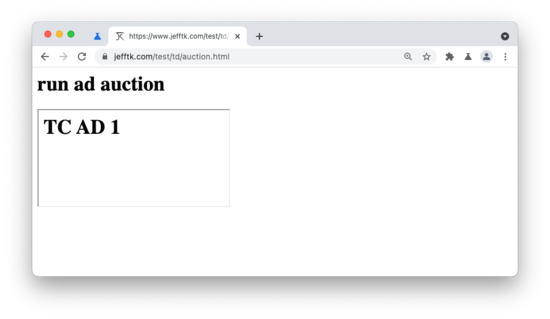(I work at Google, but not on Chrome. Speaking only for myself.)
Chrome has proposed TURTLEDOVE to support remarketing ads without sending your browsing history to advertisers. (discussed in why I work on ads). Since the overall proposal is very complicated and requires large changes, they have also proposed an initial version, FLEDGE, that they expect to build and ship this year. They're building it incrementally, and they've now checked in very initial prototype support.
Lots of things are still missing, but if you download Chrome
Canary and start it with
--enable-features=FledgeInterestGroupAPI,FledgeInterestGroups
you can play with what they have. For example, on my Mac this looks like:
"/Applications/Google Chrome Canary.app/Contents/MacOS/Google Chrome Canary" --enable-features=FledgeInterestGroupAPI,FledgeInterestGroups
I made a demo:
- Visit auction.html. You should see "no turtledove winner" because you are not yet in any turtledove interest groups.
- Visit join.html. You should see "joined interest group", because it is adding you to an interest group.
- Visit auction.html again. This time, you should see an iframe containing "TC AD 1". This is an ad selected by a turtledove auction.
Things I ran into in setting up the demo:
Even though the spec uses
snake_casethe implementation usescamelCase(#156)DevTools support is still minimal
You have to send
X-Allow-FLEDGE: trueresponse headers on anything the FLEDGE API is fetching.
Keep in mind that this is a minimal initial implementation, and there are large parts of the spec they haven't gotten to yet. If something that is implemented doesn't work yet, though, it's probably worth filing a bug.
Comment via: facebook

The prototypical use case is something like:
You visit Amazon and add a blender to your shopping cart
You visit the NYT, Amazon shows a blender ad to see if you want to come back and complete the purchase
Today this happens via third-party cookies, but with FLEDGE this would look like:
On the Amazon page, when you put the blender in your shopping cart Amazon would call the FLEDGE API
joinAdInterestGroupto add you to some sort ofamazon.com:prospective-blender-purchasersinterest group.On the NYT page, their ad network calls the FLEDGE API
runAdAuction, and includes Amazon as a buyer. Amazon gets to run JavaScript in an isolated context which can look atamazon.cominterest groups, see that you are in theprospective-blender-purchasersgroup and bid to show you a blender ad.What you are calling "tags" would normally be called "user lists" or, in the language of FLEDGE, an "interest group". (And "tags" are something entirely unrelated: snippets of JS people put on pages)
The incentive to provide true information in the simple version is that the advertiser is leaving a note for themself.
(There's also a more complicated version, where an ad tech company makes some deals. For example, say
ads.examplecontracts with a car website. On each page, the website includes some code fromads.examplethat adds users toads.example:cars. Then, the ad tech company contracts with an advertiser, and agrees to target their ads to users who are in theads.example:carsinterest group.)